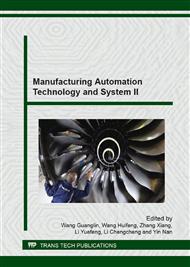p.246
p.253
p.260
p.268
p.274
p.282
p.288
p.294
p.304
Generator Stator Bar-Ends Cure-Heating Monitor System on Fuzzy PID
Abstract:
The process of electric generator stator bar-ends cure-heating is a key step during the generator production. However, since the cure-heating system is a non-linear and one-step inertial system of great coupling. Because of the resistance wire (or wire rod body resistance), air convection, the temperature and other environmental factors, it is difficult to establish accurate mathematical mode. The traditional PID control system does not achieve the desired effect. On the one hand, its overshoot is so large that the tolerance can be up to 6, on the other hand, it is difficult to regain balance once the system is perturbed. The paper makes a thermal chemical analysis of the cure-heating system, then builds a thermodynamics model. To control the non-linear and one-step inertial system, it adopts the method of Fuzzy self-tuning PID parameters to adjust the PID parameters including, and the output according to the real-time heating temperature feedback, thus, controlling the heaters action to achieve the objective of heating temperature control and solving the strong-coupling between the multi-loops of heating and improve the automatic control degree of the cure-heating control system. By simulating in MATLAB and analyzing the simulated results comparing Fuzzy-PID control effects with traditional PID, the results show that the method of Fuzzy-PID control which is used to realize the real-time control of temperature in the stator bar-ends cure-heating system can exert strongpoint and avoid shortcoming of those two control methods. As it can not only exploit the advantages of Fuzzy control, such as strong Robinson Crusoe, fast response time, small overshoot, but also possesses the high quality dynamic tracking function and better static precision of PID control, it is a superior excitation temperature control scheme for stator bar-ends cure-heating system.
Info:
Periodical:
Pages:
274-281
Citation:
Online since:
August 2014
Authors:
Keywords:
Price:
Сopyright:
© 2014 Trans Tech Publications Ltd. All Rights Reserved
Share:
Citation:


